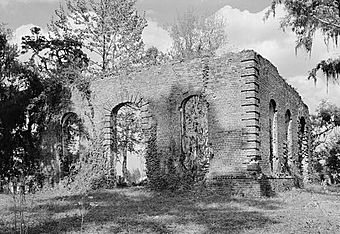Biggin Church Ruins facts for kids
Quick facts for kids |
|
|
Biggin Church Ruins
|
|

Biggin Church Ruins in 1940
|
|
| Location | 2 miles northeast of Moncks Corner on South Carolina Highway 402, near Moncks Corner, South Carolina |
|---|---|
| Built | ca. 1761 |
| NRHP reference No. | 77001215 |
| Added to NRHP | December 13, 1977 |
The Biggin Church Ruins are the remains of an old church in Berkeley County, South Carolina. You can find them about 2 miles (3.2 km) from Moncks Corner, South Carolina. This historic church has a long history, having been burned down three times!
The first church building was put up around 1711. The ruins you see today are from a church built in 1761 and rebuilt in 1781. Biggin Church was once the main church for the St. John's, Berkeley area. It was added to the National Register of Historic Places on December 13, 1977. As of 2025, the ruins are still part of the land belonging to Strawberry Chapel.
Contents
A Look Back in Time
The place where the church stands, Biggin Hill, might be named after a place called Biggin Hill in London, England. The area known as the Parish of St. John's, Berkeley was created in the early 1700s. This was a very large area, and these parishes helped with both religious and government tasks in the colony. A generous person named John Colleton donated the land for the church.
The First Church Building
The very first church was built around 1711. It replaced an older wooden building used for services. Sadly, this first church was destroyed by a forest fire around 1755.
Rebuilding and Revolutionary War
A new church was built in 1761. Important people like Henry Laurens and William Moultrie were part of this church. During the American Revolutionary War, British soldiers used the church as a storage place. When they left in 1781, they burned the church and their supplies. But the community rebuilt the church again!
The Civil War and Beyond
The church was used until the American Civil War. During the war, its furniture was taken out, and the building was damaged. After the war, the church was not cared for. Around the late 1800s, another forest fire burned the church one more time. After this fire, people took bricks from the ruins to use for other building projects.
What It Looked Like
The church was a rectangular building made of brick. It was about 30 feet (9.1 m) wide and 60 feet (18.3 m) long. The bricks were laid in a special pattern called English bond. Today, only two walls of the church remain standing.
One wall was likely the main entrance. It has a large doorway with a special frame called a Gibbs surround. On each side of the doorway, there are two arched windows. The other remaining wall was at the end of the church. It has a door with windows on either side. You can also see special corner stones called quoins and a raised brick band near the bottom of the wall.
Special Church Items
A special stone tablet remembering an early church leader was moved from Biggin Church. It is now at Strawberry Chapel, which is about 10 miles (16.1 km) away. The silver Communion set from Biggin Church was hidden during the American Civil War. It was found buried in a barn in 1947! This silver was returned to Strawberry Chapel and is now on display at the Charleston Museum.
There is also a cemetery nearby that is still used today. It includes the grave of Sir John Colleton III, who was a great-grandson of the original land donor.
Images for kids




